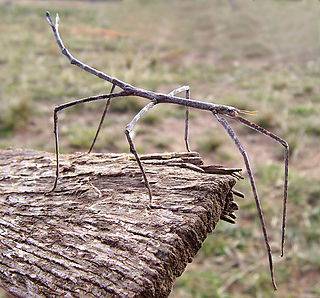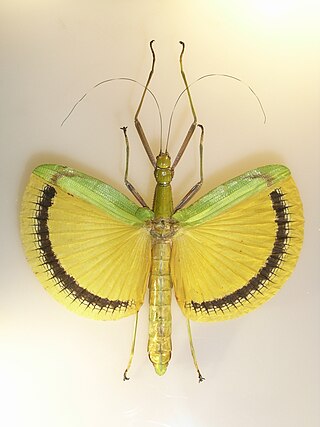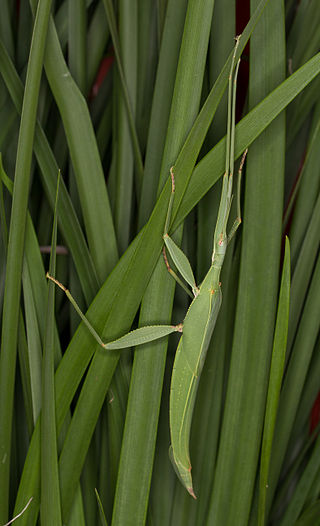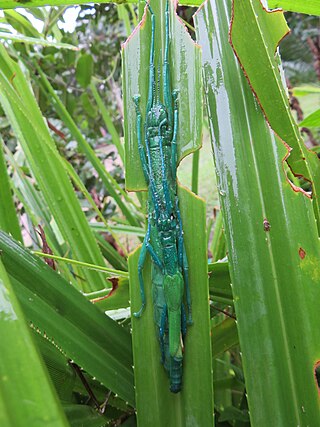
The family Phylliidae contains the extant true leaf insects or walking leaves, which include some of the most remarkably camouflaged leaf mimics (mimesis) in the entire animal kingdom. They occur from South Asia through Southeast Asia to Australia. Earlier sources treat Phylliidae as a much larger taxon, containing genera in what are presently considered to be several different families.

The Phasmatinae are a subfamily of stick insects in the family Phasmatidae. They contain at least three tribes; Bradley and Galil corrected the spelling to "Phasmatinae" and provides a key to tribes.

Acrophylla titan, the titan stick insect, is the second-longest stick insect found in Australia. First described by William Sharp Macleay in 1826, it was considered to be the longest stick insect in the world until the discovery of Ctenomorpha gargantua.

Onchestus rentzi is an Australian species of stick insect, commonly named the crowned stick insect, described in 2006. It lives in rainforests along the coast of Queensland and the Northern Territory. It is named after the Australian orthopterist David Rentz.

Anchiale austrotessulata, the tessellated stick insect, tessellated phasmid or tessulata stick insect, is a medium-sized, stick insect found in the Brisbane area of Australia. Fully grown males in mating season exhibit frenetic behaviour. This species is also parthenogenetic.

Necrosciinae is a subfamily of the stick insect family Lonchodidae, with its greatest diversity in South-East Asia.
In Greek mythology, Megareus or Megarus (Μεγαρέως) was king of Onchestus in Boeotia. In some myths, he was the eponymous king of Megara.

Ctenomorpha marginipennis, the margin-winged stick insect, is a species of stick insect endemic to southern Australia. The species was first described by George Robert Gray in 1833.
Ctenomorpha gargantua, the gargantuan stick insect, is a species of stick insect that is endemic to rainforests in northeastern Queensland, Australia. It is Australia's longest stick insect and among the world's longest stick insects, with females having been confirmed at up to 56.5 cm (22.2 in) in total length, including extended legs and cerci, but they can likely grow even larger, as there are unconfirmed measurements of up to 61.5 cm (24.2 in). Both sexes are brown, but males only reach about two-thirds the length of females and they are also thinner.

Sipyloidea is a genus of stick insects of the family Lonchodidae. Species have been recorded from India, China, Indochina, through to Australasia. The genus was described by Brunner von Wattenwyl in 1893.
In Greek mythology, Onchestos or Onchestus was the eponymous founder of the city of Onchestus in Boeotia, where the Onchestian Poseidon had a temple and a statue.

The Tropidoderinae are a sub-family of stick insects in the family Phasmatidae: genera are found in Africa, tropical Asia and Australasia.

Phasmatini is a tribe of stick insects in the family Phasmatidae. There are more than 40 described species, found in Australasia, and Asia

Megacrania is a genus of the subfamily Megacraniinae of stick insects. Members of this genus are commonly referred to as "peppermint stick insects", due to the characteristic odor of their defensive spray, as well as the cylindrical, twig-like shape of their bodies.

The Megacraniinae are an anareolate subfamily of stick insects in the family Phasmatidae. Their known distribution includes Malesia and islands in the Pacific and Indian oceans. Several genera have been revised and were placed previously in the Platycraninae.

Anchiale is a genus of stick insects in the family Phasmatidae and tribe Phasmatini. Species have a known distribution from Australasia. The type species, A. maculata, was originally thought to be a Mantis.

Ctenomorpha is a genus of phasmids belonging to the family Phasmatidae.
Pachymorpha is a genus of phasmids belonging to the family Diapheromeridae.
Scionecra is a genus of Asian stick insects in the tribe Necrosciini, erected by Heinrich Hugo Karny in 1923. Species have been recorded from: China, Vietnam, Malesia through to Australia.










